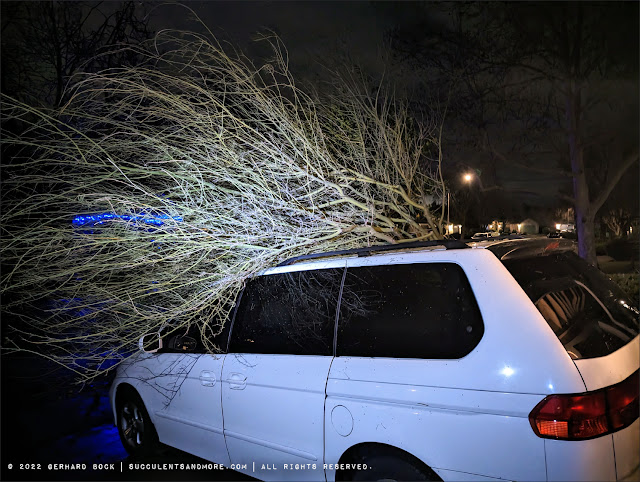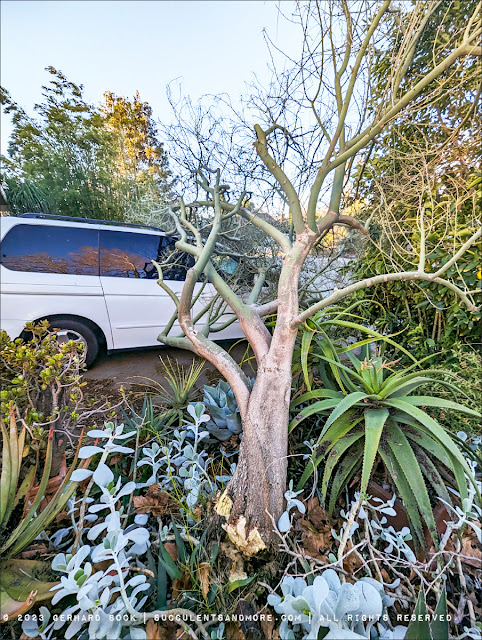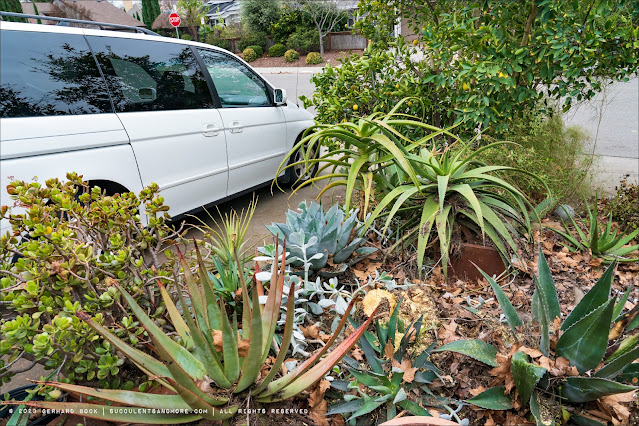Tree down!
New Year’s Eve was rainy and extremely windy—University Airport on the edge of the University of California Davis campus recorded gusts close to 50 mph. In our backyard, the sun sail tore lose from two of its four anchor points, and the wind chimes were clanging like crazy. Thousands of households in Davis lost power from downed lines. Fortunately, we were spared, but when our friend, who’d been over for New Year’s Eve, was leaving, we saw this:
 |
| Agave parrasana (left), Aloe helenae (top middle), Aloe ‘Maui Gem’ (Aloe mawii × globuligemma, right), all undamaged |
 |
| Aloe helenae (top), Aloe ‘Maui Gem’ (bottom) |
Before I can plant anything new, I need to wait until the stump has disintegrated. I’ll follow Bob Villa’s advice on killing a stump using Epsom salt (magnesium sulfate); it takes longer than harsh chemicals, but it’s safer for the environment and the plants nearby.
Lessons learned from growing (and eventually losing) three palo verde trees
1. I would still recommend ‘Desert Museum’ because it’s thornless and (mostly) seedless, and it flowers literally six months of the year. However, make sure the tree you pick is cutting-grown, not grafted, to avoid issues with suckers sprouting from the rootstock (highly annoying!) and potential breakage due to a weak graft.
2. Plant your palo verde in an unirrigated area. Water periodically during the first summer, then leave it to its own devices. This ensures that the roots grow down instead of out, and it slows down the growth overall, resulting in a more solid tree that is less prone to falling over.
3. Shape the heck out of your palo verde. Remove branches that cross or rub against each other. This article has great tips on how to prune desert trees like palo verdes. Don’t be afraid to trim and prune when the tree is young. We were far too timid in that regard, forcing us to remove larger branches when our tree was older. This led to unsightly scars and to a less balanced tree with an unevenly distributed weight load. Ultimately, this may have contributed to what happened on New Year’s Eve.











It's great that the downed tree didn't cause more damage but nonetheless heartbreaking to lose it like that. Looking at the photo showing all the plants situated around its base, I'm also amazed that they weren't uprooted. I hope you can find a cutting-grown plant in the not-too-distant future. Thanks for sharing your "lessons learned."
ReplyDeleteI'm going to wait until the fall before planting a new tree. Right now, I'm leaning towards a seedless desert willow, like Chilopsis linearis 'Timeless Beauty'. But who knows what I'll ultimately decide :-).
DeleteIt's sad and dangerous to lose a tree to a wind storm, but if a tree is going to come down, I can't think of a luckier break! (No pun intended). Will some of the trunk be repurposed?
ReplyDeleteChavli
Repurposing the trunk: Funny you should ask! A friend came by early this morning to pick the trunk sections and some of the thicker branches. Her husband is a woodworker and will make something cool out of them.
Delete"Lessons learned from growing (and eventually losing) three palo verde trees"... ugh, does this mean you are now completely without a palo verde? It was so nice of the tree to not damage your vehicle or the plants, what are the chances. Reminds me of when that bear trapesed through our back garden and didn't break a single pot or twig.
ReplyDeleteNot a great way to ring in the New Year. Rather serendipitous your van kept the tree from damaging everything underneath and didn't damage the vehicle either. Wild and woolly weather across the continent this year. Will be interesting to see how this affects the various woody plants.
ReplyDeleteNo one injured, thankfully! Picking out a new tree will be a fun--if that is possible consolation.
ReplyDelete